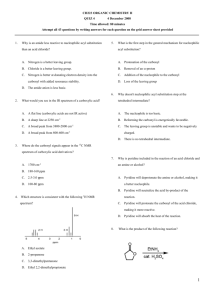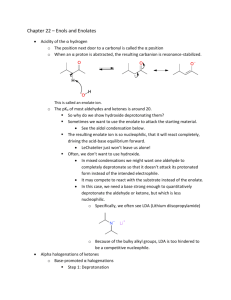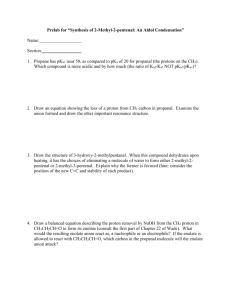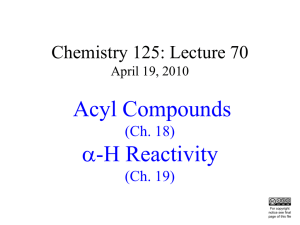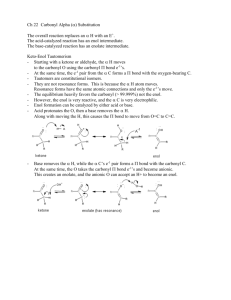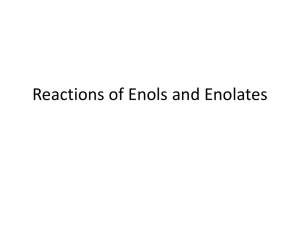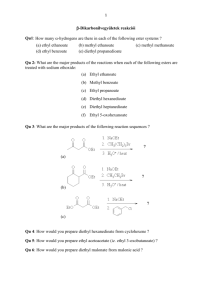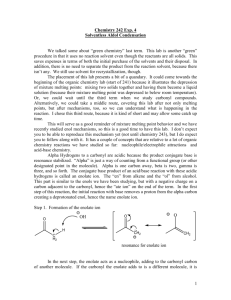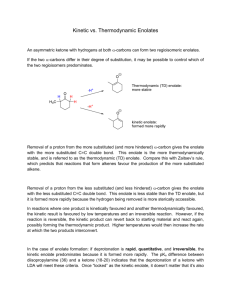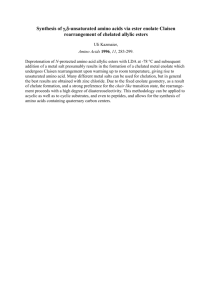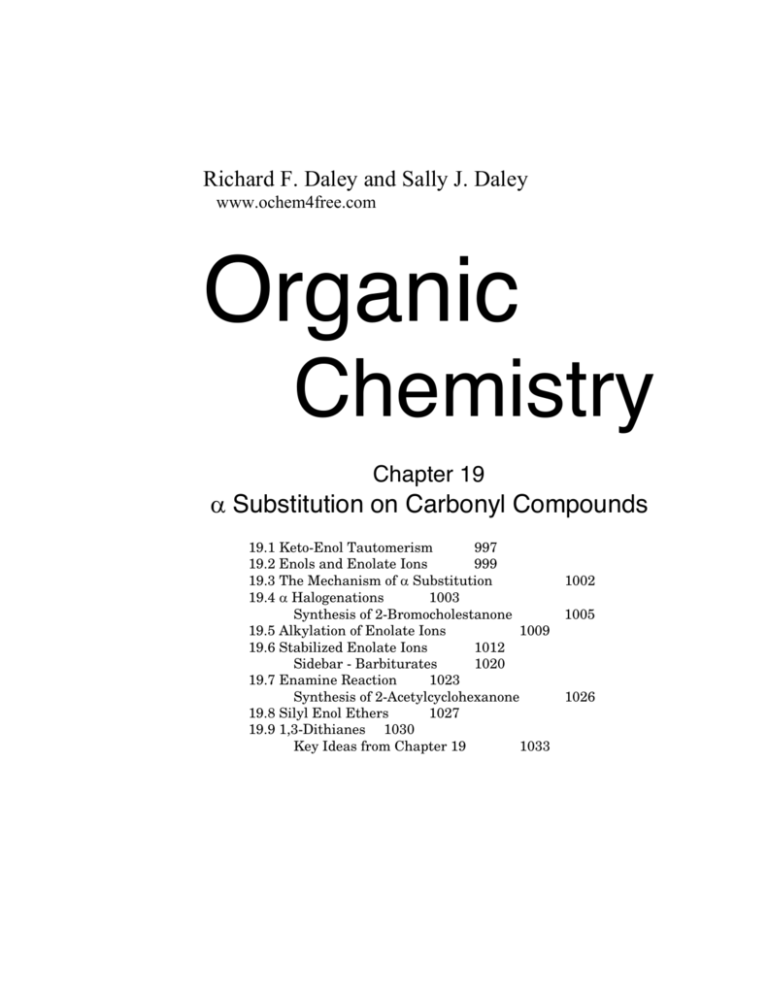
Richard F. Daley and Sally J. Daley
www.ochem4free.com
Organic
Chemistry
Chapter 19
D Substitution on Carbonyl Compounds
19.1 Keto-Enol Tautomerism
997
19.2 Enols and Enolate Ions
999
19.3 The Mechanism of D Substitution
19.4 D Halogenations
1003
Synthesis of 2-Bromocholestanone
19.5 Alkylation of Enolate Ions
1009
19.6 Stabilized Enolate Ions
1012
Sidebar - Barbiturates
1020
19.7 Enamine Reaction
1023
Synthesis of 2-Acetylcyclohexanone
19.8 Silyl Enol Ethers
1027
19.9 1,3-Dithianes 1030
Key Ideas from Chapter 19
1033
1002
1005
1026
Organic Chemistry - Ch 19
994
Daley & Daley
Organic Chemistry - Ch 19
995
Daley & Daley
Copyright 1996-2005 by Richard F. Daley & Sally J. Daley
All Rights Reserved.
No part of this publication may be reproduced, stored in a retrieval system, or
transmitted in any form or by any means, electronic, mechanical, photocopying,
recording, or otherwise, without the prior written permission of the copyright
holder.
Organic Chemistry - Ch 19
996
Daley & Daley
Chapter 19
D Substitution on Carbonyl
Compounds
Chapter Outline
19.1
Keto-Enol Tautomerism
Understanding the factors affecting the
equilibrium between the keto and enol forms of
a carbonyl compound
19.2
Enols and Enolate Ions
Mechanism for the formation of enols and
enolate ions
19.3
19.4
19.5
19.6
The Mechanism of D Substitution
The generalized mechanism for an D
substitution reaction
D Halogenations
Reactions that place a halogen on the D carbon
of a carbonyl compound
Alkylation of Enolate Ions
D Alkylation of a carbonyl compound
Stabilized Enolate Ions
Some functional groups that increase the
stability of an enolate ion
19.7
Enamine Reaction
Synthesis and reactions of nitrogen analogs of
enols
19.8
Silyl Enol Ethers
Formation and reactions of silyl ethers of enols
19.9
1,3-Dithianes
Synthesis and uses of these sulfur analogs of
acetals
Organic Chemistry - Ch 19
997
Daley & Daley
Objectives
✔ Write a mechanism for the formation of an enol or an enolate ion
from a ketone or aldehyde
✔ Know the generalized mechanism for either an acid-catalyzed or
base-assisted D substitution reaction
✔ Recognize that an enolate ion is an excellent nucleophile and can
initiate an SN2 reaction with a suitable substrate
✔ Know that an additional electron-withdrawing functional group
stabilizes an enolate ion
✔ Recognize that enamines and silyl enol ethers both react in a
similar manner to enols and enolate ions
✔ Recognize synthons and their value in organic synthesis
I praise alchemy, which compounds secret medicines, whereby all
hopeless maladies are cured. Those who are ignorant of these deserve
neither to be called chemists nor physicians.
—Paracelsus
C
hapters 7 and 8 introduced you to carbonyl chemistry with
the study of nucleophilic addition and nucleophilic
substitution reactions on the carbonyl group. This chapter continues
the study of carbonyl chemistry through an examination of D
substitution reactions. An D substitution reaction occurs when some
group replaces a hydrogen atom on the carbon adjacent to the carbonyl
carbon.
Chapter 20 examines condensation reactions of the carbonyl
group. Condensation reactions and D substitution reactions are related
in that both involve enols and enolate ions as intermediates. Enols
and enolate ions are nucleophiles. The difference between an D
substitution reaction and a condensation reaction is that the
nucleophile reacts with some added electrophile in an D substitution,
but the nucleophile reacts with another carbonyl group in a
condensation reaction—often the reaction is accompanied by the loss
of a small, stable molecule (usually water).
Chapters 7 and 8 covered the portion of carbonyl chemistry
centered on the electrophilicity of the carbonyl carbon. This chapter
and Chapter 20 add to that knowledge the concept that in D
Organic Chemistry - Ch 19
998
Daley & Daley
substitution and condensation reactions the chemistry centers around
the acidity of the D hydrogen. Chemists use the condensation reaction
with enol-based nucleophiles as one of the most common methods for
forming a new carbon—carbon bond. The D substitution reactions and
the condensation reactions involving enol and enolate ions are very
useful reactions widely used by chemists in organic syntheses.
19.1 Keto-Enol Tautomerism
The keto form of a
carbonyl group
contains a C=O bond.
The enol form has a
C=C bond with an
—OH group attached
to one of the carbons.
Tautomerism is an
equilibrium between
two molecules. The
change between the two
molecules involves a
shift of a S bond and a
hydrogen atom.
Almost all carbonyl compounds exist in an equilibrium that
consists of a keto form and an enol form. To change from the keto
form to the enol form, a hydrogen ion moves from a carbon that is
alpha to the carbonyl carbon to the oxygen of the carbonyl group. This
move forms a carbon—carbon double bond with an —OH group
attached to the double bonded carbon. The equilibrium is relatively
slow in the pure carbonyl compound. In the presence of acid or base
the carbonyl compound rapidly interconverts between these two forms.
This keto-enol equilibrium is an example of tautomerism.
O
C
O
H
C
Keto tautomer
C
H
C
Enol tautomer
Tautomerism is a process whereby two isomers interconvert by
the movement of an atom or a small group of atoms—in this case a
hydrogen—between two atoms. You cannot readily separate the two
chemical species that make up the tautomer. The keto form and the
enol form of a carbonyl group are examples of tautomers.
Tautomerism versus Resonance
Tautomerism is different from resonance. Resonance structures are used to try to
depict the structure of a molecule where the contributors differ only in the position of
the electrons. The actual molecule is a combination of all the resonance contributors.
Tautomers differ in the position of an atom. Generally, a hydrogen changes position in
a tautomer. In carbonyl compounds the hydrogen moves between the D carbon and the
oxygen. Resonance and tautomerism are similar in that the molecule assumes the
chemical reactivity of all species shown in the resonance or tautomerism. However,
unlike individual resonance contributors, individual tautomers really do exist.
Most carbonyl compounds exist almost entirely in their keto
tautomer form. For example, cyclohexanone contains only about .007%
Organic Chemistry - Ch 19
999
Daley & Daley
of the enol tautomer, acetone about 10–5% of the enol tautomer and
acetaldehyde essentially has no enol tautomer. The amount of enol
tautomer in carboxylic acids and their derivatives is also less than
that found in the ketones. Despite the low concentration of the enol
form, enol tautomers are very important to chemists working with a
carbonyl group because of their reactivity. When chemists do a
reaction involving a carbonyl compound, they frequently include steps
that encourage an increase in the amount of enol tautomer present.
OH
O
H
99.993%
Keto tautomer
0.007%
Enol tautomer
Cyclohexanone
Factors that make the enol more stable increase the amount of
enol dramatically. For example, a E dicarbonyl compound has two
possible enols and both are conjugated. Conjugation increases the
stability of the enol tautomers and thus increases the amount of enol
tautomer present. As a result, 80% of 2,4-pentanedione is in the enol
form.
O
O
OH
CH3CCH2CCH3
CH3C
O
O
CHCCH3
CH3CCH
Keto tautomer
(20%)
OH
CCH3
Enol tautomers
(80%)
The structural arrangement of some compounds can stabilize
the enol form, too. For example, the two enol tautomers of 2,4pentanedione can form an internal hydrogen bond, which enables the
hydrogen to move readily from one oxygen to the other.
O
O
Keto tautomer
(20%)
Exercise 19.1
O
H
O
O
Enol tautomers
(80%)
H
O
Organic Chemistry - Ch 19
1000
Daley & Daley
Of the various enol forms of 1-phenyl-1,3-butanedione, one is
significantly more stable than the rest. Which is the most stable?
Explain your choice.
O
O
1-Phenyl-1,3-butanedione
19.2 Enols and Enolate Ions
Both acids and bases catalyze the formation of the enol
tautomer. With an acid catalyst, the carbonyl oxygen protonates first
to yield a resonance-stabilized cation. The cation then loses a proton
and becomes an enol.
••
O
C
•
•
••
•
•
••
H
OH2
C
••
•
•
O
C
O
H
H
C
C
Keto tautomer
•
•
••
O
C
An enolate ion is an
enol that has lost its
acidic proton resulting
in a resonancestabilized anion.
H
H
C
Enol tautomer
H
C
H
•
•
••
OH2
With base catalysis, the base removes the proton from the D
carbon to form a resonance-stabilized anion called an enolate ion.
The enolate ion picks up a proton to yield the enol.
Organic Chemistry - Ch 19
1001
•
•
••
O
C
•
•
••
O
C
Daley & Daley
••
C
H
••
OH
••
••
•
•
O
••
H
•
•
••
OH
C
C
Keto tautomer
•
•
••
C
Enol tautomer
O••
C
H
H
C
••
OH
••
Enolate ion
Acidity of Protons in a Carbonyl Compound
The base removes only D protons from a carbonyl-containing compound. Protons on
other carbons in the molecule are not as acidic, so they do not ordinarily react with a
base. The electron-withdrawing character of the carbonyl group gives the D protons
their acidity.
See Section 7.7, page
000, for more
explanation of the
positive character of
various types of
carbonyl groups.
The D protons of ketones and aldehydes are more acidic than
the D protons of carboxylic acid derivatives because the carbonyl
groups of ketones and aldehydes are more electron withdrawing. The
difference in electron withdrawing ability is due to the reduced partial
positive charge on the carbonyl carbon caused by the nonbonding
electrons on the heteroatom in the carboxylic acid family. Thus,
ketones and aldehydes enolize more readily than carboxylic acid
derivatives.
Typically, the pKa for an D hydrogen of an aldehyde or ketone
is about 20. For a carboxylic acid derivative, it is about 23. Although
treating most carbonyl-containing compounds with hydroxide ion in
water (pKa = 15.7) or alkoxide ion in alcohol (pKa = 16 to 19) gives an
equilibrium mixture that contains both the enol and the enolate ion,
the amount of enolate ion is small. Carboxylic acids form enolate ions
with difficulty because the acidic proton (pKa ~ 5) of the acid group
reacts first.
Although enolate ions behave similarly to enols, they are much
more reactive. Thus, enolate ions are nucleophiles and react with
electrophiles in much the same way as do alkenes. Even in small
concentrations, enolate ions are useful synthetic reagents. In most
cases, running a reaction with an enolate ion is more advantageous
than running it with an enol. Enols form in catalytic quantities of acid
Organic Chemistry - Ch 19
1002
Daley & Daley
or base, but enolate ions form exclusively in an equivalent amount of
strong base.
Exercise 19.2
Treatment of (S)-2-methylcyclohexanone with either an aqueous acid
or an aqueous base forms a racemic mixture. Write a mechanism to
explain this observation.
Some reactions involving enolate ions require that the carbonyl
compound change 100% to its enolate ion. In reactions such as these,
chemists must use a stronger base than a hydroxide ion or an alkoxide
ion, which often only produce small amounts of enolate ion. One of the
more common bases used for this purpose is lithium diisopropylamide
(LDA). LDA is the lithium salt of diisopropyl amine.
((CH3)2CH)2NH
Li
CH3CH2CH2CH2
((CH3)2CH)2N Li
Diisopropyl amine, with a pKa of about 40, is much less acidic
than the C—H bond D to the carbonyl group. Thus, the
diisopropylamide anion is a very strong base. Because of its large size,
the diisopropylamide ion is not very nucleophilic. Therefore, it does
not react with a carbonyl group as a less bulky base would. When it
reacts with a carbonyl-containing molecule, it abstracts the D proton
to form the lithium salt of the enolate ion. In summary, LDA is a
strong base, but a poor nucleophile.
O
O
O
((CH3)2CH)2N Li
Exercise 19.3
Draw the important resonance contributors for all possible enolate
ions of the following molecules. If there are more than one enolate ion,
indicate which would form most easily.
a) Acetone
c) 1,3-Cyclohexanedione
b) Cyclopentanone
d) 3-Methyl-2-pentanone
Organic Chemistry - Ch 19
1003
Daley & Daley
Sample solution
a)
•
•
••
O
•
•
••
CH3C
CH2
••
O ••
CH3C
CH2
19.3 The Mechanism of D Substitution
Because enols and enolate ions have a large amount of
carbon—carbon double bond character, they react similarly to alkenes.
The D carbon has a significantly higher electron density than does the
carbon bearing the oxygen. Thus, an incoming electrophile reacts
regiospecifically with the carbon adjacent to the carbon bearing the
oxygen.
In an acidic solution, an D substitution proceeds along the
following steps: 1) The enol forms in the manner described in Section
19.2. 2) The nonbonding pair of electrons from the oxygen moves down
to make a S bond between the carbon and oxygen. 3) At the same time
a reaction occurs between the S electrons from the double bond and
the electrophile. 4) The oxygen loses the proton it gained when
forming the enol to complete the formation of the D substituted
carbonyl compound.
••
•
•
O
C
•
•
H
C
••
O
C
H
•
•
E
C
•
•
O
C
H
•
•
Base
E
C
••
O
C
E
C
An D substitution taking place in a basic solution proceeds as
follows: 1) The enolate ion forms in the manner described in Section
19.2. 2) One of the nonbonding electron pairs on the oxygen moves
down and makes a S bond between the carbon and oxygen. 3) The S
electrons from the carbon—carbon double bond react with the
electrophile to produce the D substituted carbonyl compound.
Organic Chemistry - Ch 19
•
•
1004
••
•
•
O
C
B••
H
••
O••
C
C
Daley & Daley
•
•
E
••
O
C
C
E
C
Exercise 19.4
- OD in D O,
2-Methyl-1-phenyl-1-butanone, when reacted with c
2
undergoes a deuteration. Write a mechanism for this reaction.
O
O
D
OD
D2O
19.4 D Halogenations
Treating a ketone or an aldehyde with chlorine, bromine, or
iodine in either an acidic or basic solution halogenates the carbonyl
compound at the D position.
•
•
••
•
•
O
C
H
C
X2
Acid or base
••
O
C
X
C
Both the acid-catalyzed and the base-assisted reactions follow the
typical pattern for the D substitution reactions of carbonyl compounds.
The acid-catalyzed reaction proceeds through the enol intermediate,
and the base-assisted reaction via an enolate ion intermediate.
The formation of the enol or enolate ion is the rate-determining
step of the D halogenation reaction. This was determined
experimentally in several ways. First, chemists found that the rate of
D halogenation stayed the same regardless of which halogen they
used. Second, when they changed the concentration of either the
carbonyl or the hydrogen ion, the rate of the reaction changed. These
observations demonstrated that the rate-determining step of the
reaction does not include the halogen. Thus, they determined that the
rate law for an D halogenation reaction is as follows:
Rate = k[Carbonyl compound][H]
Organic Chemistry - Ch 19
1005
Daley & Daley
Additionally, a set of parallel reactions helped confirm the rate
law for an D halogenation. In one reaction, chemists reacted a carbonyl
compound with a halogen. In the parallel reaction, they reacted the
same carbonyl compound with the D in D2O instead of with the
halogen.
•
•
••
•
•
O
C
D3O
H
••
O
C
C
D
C
They compared the rates of the two reactions and found them to be the
same. The reaction with D2O simply replaced the D hydrogen with
deuterium in the same way that the halogen replaced the D hydrogen
in the other reaction. Thus, because the rates of reaction are the same
for both reactions, the formation of the enol must determine the rate of
reaction.
In summary, the net halogenation reaction consists of two
steps. The enol intermediate forms first and is the slower, ratedetermining step. Next, the halogen rapidly adds to the enol to form
the D halocarbonyl compound.
•
•
••
O
H
C
•
•
OH2
H
••
C
C
••
•
•
O
C
H
H
••
X
••
••
X••
••
••
•
•
O
••
•
•
OH2
H
H
C
O
C
H
•
•
C
••
X
•
•
•
•
••
X••
••
•
•
(Slow)
C
C
••
•
•
C
O
••
O
C
•
•
••
X••
(Fast)
C
An example of an D substitution reaction is the D chlorination of
2-methylcyclohexanone. Notice that the halogenation takes place on
the more substituted of the two possible enols.
Organic Chemistry - Ch 19
1006
Daley & Daley
O
O
CH3
CH3
Cl2
Cl
CH3COOH
2-Chloro-2-methylcyclohexanone
(73%)
Synthesis of 2-Bromocholestanone
O
H
O
H
H
Cholestanone
Br2, CH3COH Br
HBr
H
O
H
H
2-Bromocholestanone
(60%)
Into a 100 mL round bottom flask put 3.9 g (1 mmol) of cholestanone and 30 mL of
glacial acetic acid. Add 5 drops of 48% aqueous hydrogen bromide. To this solution
add a solution of 1.7 g of bromine dissolved in glacial acetic acid dropwise for a period
of about 30 minutes. Stir the solution for an additional 3 hours. Pour the reaction
mixture into 250 mL of water and extract with 50 mL of ether. Wash the ether with
sodium bicarbonate solution and dry over anhydrous sodium sulfate. Evaporate the
ether, and recrystallize the product from ethanol. The yield of product is 2.8 g (60%),
m.p. 169-170oC.
Discussion Question
1. Why does the bromination occur on C2 rather than on the other side of the
carbonyl group (C4)?
D-Haloketones and D-haloaldehydes are useful synthetic
intermediates because they readily dehydrohalogenate to form D,Eunsaturated ketones and D,E-unsaturated aldehydes. Chemists use
D,E-unsaturated carbonyls as intermediates in a variety of reactions.
D,E-Unsaturated carbonyl compounds form through E2 elimination
reactions. The base most commonly used in these reactions is
pyridine, a non-nucleophilic base.
Organic Chemistry - Ch 19
1007
O
Daley & Daley
O
CH3
Cl
CH3
N
Exercise 19.5
Propose a synthesis of 1-penten-3-one.
The Hell-VollhardZelinskii reaction is a
synthetic method for
the D halogenation of a
carboxylic acid.
Because the D hydrogens of carboxylic acids and their
derivatives are less acidic than those of aldehydes and ketones,
carboxylic acid derivatives also do not readily halogenate under the
above conditions. This lower D hydrogen acidity causes the enol to
form at a correspondingly slower rate, which makes the formation of
the halogen bond more difficult than with aldehydes and ketones.
Chemists usually D brominate carboxylic acids using a mixture of
bromine and phosphorus tribromide in what is known as the HellVollhard-Zelinskii (HVZ) reaction.
O
O
CH3CH2CH2COH
1) Br2, PBr3
2) H2O
CH3CH2CHCOH
Br
2-Bromobutanoic acid (92%)
Formation of an acyl
halide is discussed in
Section 8.3, page 000.
The first step in the HVZ reaction forms an acyl bromide plus
HBr. The HBr then catalyzes the enolization of the acyl bromide,
which rapidly reacts with the bromine to produce the Dbromoacyl
bromide. Because of its high reactivity, Dbromoacyl bromide is
difficult to handle and to purify. Therefore, it is hydrolyzed to the Dbromo carboxylic acid product.
Organic Chemistry - Ch 19
1008
O
The mechanism for the
formation of the acyl
halide is found in
Section 8.3, page 000.
Daley & Daley
O
RCH2COH
P, Br2
•
•
••
OH
RCH
RCH2CBr
C
•
•
••
•
•
Br
••
••
••
Br••
Br
••
••
•
•
RCHC
•
•
••
••
•
•
O
OH
••
–H
OH
••
Br••
•
•
••
Br••
•
•
••
–H
••
RCH C
O
Br••
••
RCHC
•
•
OH
••
••
•
2 •
••
H
••
Br••
••
Br••
••
HO
The final step of the reaction is the acid-catalyzed D bromination of a
carboxylic acid. The key steps of the reaction are the formation of the
acyl bromide and the enolization of the acyl halide.
As with an acid, the rate-determining step when a base
promotes the Dhalogenation of a ketone or an aldehyde is the step
that forms the enolate ion intermediate. Chemists used many of the
same sorts of experiments to show this as they did with the acidcatalyzed reaction. Like the acid-catalyzed reaction, the kinetics of the
reaction in basic solution depends only on the concentration of the
carbonyl compound and base. The rate law for this reaction is as
follows:
- OH]
Rate = k[Carbonyl compound][c
As you may remember,
Le Chatelier’s principle
states that if a reaction
at equilibrium is
disturbed, it will
adjust to reduce the
effects of that
disturbance.
Even relatively weak bases, such as the hydroxide ion,
effectively promote halogenation because only low concentrations of
the enolate ion are necessary for the reaction to occur. Enolate ion
formation is an equilibrium reaction. This is an example of the use of
Le Chatelier’s principle. A reaction can proceed using a minor
component of the equilibrium, because the system attempts to
maintain the equilibrium. As the enolate ions react, more enolate ions
form from the ketone or aldehyde, thus maintaining the equilibrium.
•
•
••
O
C
H
C
•
•
••
•
•
••
OH
••
H2O••
••
O••
C
•
•
C
••
Br
••
••
•
•
Br
••
•
•
••
O
••
C
C
•
•
Br
••
Chemists seldom use base-assisted halogenations of ketones for
organic syntheses because the halogenation is difficult to stop after
Organic Chemistry - Ch 19
The haloform reaction
introduces a halogen
onto the methyl group
of a methyl carbonyl
compound.
1009
Daley & Daley
one substitution. Due to the electron-withdrawing nature of halogens,
the presence of a halogen on the product increases the acidity of any
remaining D hydrogens. Thus, the monohalogenated product rapidly
enolizes and forms a dihalogenated product.
The haloform reaction is an example of a base-promoted
halogenation in which multiple halogenations are desirable. The
substrate in a haloform reaction is a methyl ketone. When treated
with a halogen in the presence of a base, the methyl ketone produces a
carboxylic acid and a haloform (chloroform CHCl3, bromoform CHBr3,
or iodoform CHI3). Chemists have long used the iodine haloform
reaction as a qualitative test for a methyl group attached to a carbonyl
group. An off-white to yellow precipitate indicates the presence of a
methyl group.
O
O
R
CH3
I2
NaOH
R
O
CI3
NaOH
H2O
R
O
+ CHI3
Solved Exercise 19.1
The reaction of the 1,1,1-triiodoketone with sodium hydroxide ion is a
nucleophilic substitution at the carbonyl group. The leaving group is the c
CI3 ion. Write a mechanism for the reaction and explain why this ion acts as
the leaving group.
Solution
There are three steps in this mechanism.
Step 1
The hydroxide ion adds to the carbonyl group.
O
R
O
CI3
OH
H2O
R
OH
CI3
Step 2
- CI ion.
The tetrahedral intermediate loses the c
3
O
R
OH
Step 3
O
CI3
R
OH
+
CI3
Organic Chemistry - Ch 19
1010
Daley & Daley
- CI ion.
The acidic proton of the carboxylic acid transfers to the c
3
O
R
O
O
H
+
CI3
R
+ H
O
CI3
- CI ion is slightly more basic than either the c
- OH or the
Because the c
3
c
c
RCOO ions, it is the poorest leaving group. However, the CI3 ion forms
CHI3, which is insoluble in the reaction mixture. Because CHI3 is insoluble,
an equilibrium is never established.
Exercise 19.6
Why do chemists describe halogenations that take place in an acidic
solution as acid-catalyzed, but they describe halogenations that take
place in a basic solution as base-assisted?
Exercise 19.7
The first step in the iodoform reaction is a base-assisted iodonation.
The second step is a nucleophilic carbonyl substitution. Write a
mechanism for the haloform reaction.
19.5 Alkylation of Enolate Ions
An alkylation reaction
is an SN2 reaction with
an enolate ion
nucleophile reacting
with an alkyl halide.
One of the more synthetically useful reactions involving
enolate ions is the alkylation reaction. An enolate alkylation is an
SN2 reaction that displaces a leaving group on an alkyl group with an
enolate ion nucleophile. The net result is the formation of a new
carbon—carbon bond.
O
O
C
1) Base
C
2) RX
H
R
Enolate alkylation is subject to the steric constraints of the SN2
reaction. Because large groups cause too much crowding for the
reaction to take place, the alkyl groups that work best in enolate
alkylations are primary or methyl alkyl groups. Secondary alkyl
groups react poorly, and tertiary alkyl groups undergo mostly E2
reactions. Allylic and benzylic groups also readily alkylate an enolate
Organic Chemistry - Ch 19
A tosylate is a
particularly good
leaving group first
introduced in Section
12.6, page 000.
A bidentate (literally
“two toothed”) species is
a group containing two
reactive sites.
1011
Daley & Daley
ion. An enolate alkylation reaction also requires a good leaving group
on the substrate. The best leaving groups are tosylates and halogens.
The enolate ion, an example of a bidentate ion, has two
possible reactive sites that are resonance contributors to the structure
of the ion. Each of these reactive sites is a potential nucleophile. When
the negative charge on the oxygen reacts with the substrate, the result
is an O-alkylation product. When the negative charge on the carbon
reacts with the substrate, the result is a C-alkylation product.
•
•
••
C
O••
L
•
•
••
O
C
O-Alkylation product
•
•
••
C
O
L
••
•
•
O
••
C
C-Alkylation product
For anions,
nucleophilicity
increases from right to
left on the periodic
table. See Section 12.6,
page 000.
The use of LDA
(lithium diisopropyl
amide) is discussed in
Section 19.2, page 000.
Of the two possible products, the C-alkylation product is the
one that usually forms. Because oxygen has a higher electronegativity
than carbon, you would expect the resonance contributor with the
negative charge on the oxygen to be more important—and it is!
However, the negative charge on the carbon is by far the more reactive
nucleophile because it is both a softer and a stronger base. Thus, the
reaction occurs on the carbon in preference to occurring on the oxygen.
Using weaker bases, such as hydroxide or alkoxide ions, results
in significant amounts of SN2 or E2 reaction of the base with the
halide. Hydroxide and alkoxide ions have similar base strengths to
that of the enolate ion. Therefore, the reaction produces an
equilibrium in which both enolate ion and base react with the alkyl
halide. The best base to use with ketones is LDA because it produces
nearly 100% enolate ion before adding the alkyl halide. Thus, there is
no competing nucleophile present in the reaction mixture. LDA brings
about some side reactions with aldehydes, however, so it is not
suitable for reactions with aldehydes.
Organic Chemistry - Ch 19
1012
Daley & Daley
O
O
PhCCH2CH3
1) LDA
2) CH3CH2Br
PhCCHCH3
CH2CH3
The substrate of the enolate alkylation reaction must have only
one set of D hydrogens. If it has two sets of D hydrogens, the product
may contain a mixture of both possible monoalkylated products as
well as some dialkylated product.
Exercise 19.8
Predict the major products of the following reactions.
a)
O
1) LDA
CH2Br
2)
b)
O
1) LDA
2) CH3CH2Br
c)
O
CH3CH2CH2CCH2CH2CH3
1) LDA
2)
OTs
Sample solution
b)
O
O
1) LDA
2) CH3CH2Br
CH2CH3
Organic Chemistry - Ch 19
1013
Daley & Daley
19.6 Stabilized Enolate Ions
Stabilized enolate ions
are enolate ions with
an additional electronwithdrawing group
attached to the D
carbon. The
compounds from which
these ions are made are
called active methylene
compounds.
A E dicarbonyl
compound has two
carbonyl groups
bonded to a common
carbon atom.
All the enolate ions discussed so far are carbanions that are
stabilized through resonance with the carbonyl group. Attaching a
second electron-withdrawing group to the D carbon, however,
increases the stability of the enolate ion. Enolate ions with two
electron-withdrawing groups are called stabilized enolate ions. Of
the many possible groups that make stabilized enolate ions, ketones,
aldehydes, nitriles, and ester groups are the most frequently used.
Chemists often call the compounds used to generate stabilized enolate
ions active methylene compounds. The two electron-withdrawing
groups bonded to a carbon dramatically increase the acidity of the
protons on the carbon that bears both groups.
The most common active methylene compounds are the E
dicarbonyl compounds. The hydrogens on the CH2 between the two
carbonyl groups of a E dicarbonyl compound are much more acidic
than a compound with only one carbonyl group. For example, the pKa
of the hydrogens in acetone is 19, whereas the pKa of the hydrogens
between the carbonyl groups of 2,4-pentanedione is 9.
O
O
CH3CCH2
O
CH3CCHCCH3
H
H
pKa = 9
pKa = 19
Acetone
2,4-Pentanedione
The advantage of using an active methylene compound in a
synthesis is that the active methylene compound makes the position of
reaction unambiguous. The acidic site, and thus the location of the
enolate anion, is clearly on the active methylene carbon. The enolate
ion of a E dicarbonyl compound has three major resonance
contributors. The additional resonance contributor explains the large
increase in acidity of a E dicarbonyl compound compared to a
compound with only one carbonyl group.
•
•
••
O
•
•
••
O••
••
•
•
••
•
•
O
O
••
• •
• •
O
•
•
••
O
••
Two E dicarbonyl compounds commonly used in organic
synthesis are diethyl malonate and ethyl acetoacetate.
Organic Chemistry - Ch 19
O
1014
Daley & Daley
O
O
O
CH3CH2OCCH2COCH2CH3
CH3CCH2COCH2CH3
Diethyl malonate
Ethyl acetoacetate
Future illustrations of these compounds abbreviate the ethyl groups
with the symbol “Et.” Another common abbreviation is to use the
symbol “Me” for a methyl group.
O
Decarboxylation is the
loss of a carboxylic
acid group as carbon
dioxide.
O
O
O
EtOCCH2COEt
CH3CCH2COEt
Diethyl malonate
Ethyl acetoacetate
Both diethyl malonate and ethyl acetoacetate are readily available,
and both are important synthetic intermediates. Their importance
comes from three characteristics that both possess. The D hydrogens
are highly acidic, the enolate ions are nucleophilic, and both molecules
readily undergo decarboxylation. An D substitution reaction with
either of these E dicarbonyl compounds proceeds as follows:
O
O
O
O
O
Base
O
RX
OR'
OR'
OR'
R
H
1) OH, H2O
O
O
O
2) H3O
–CO2
OH
R
R
The end result of this sequence depends on the starting material. If
you start with diethyl malonate, the product is an alkylated acetic
acid. If you start with ethyl acetoacetate, the product is an alkylated
acetone.
Organic Chemistry - Ch 19
O
1015
O
Diethyl malonate
CH2COH
An alkylated acetic acid
O
O
1) base 1) OH, H2O
2) RX
2) H3O
CH3CCH2COEt
CH3CCH2
R
An alkylated acetone
Ethyl acetoacetate
A malonic ester
synthesis is the
alkylation of diethyl
propanedioate at C2.
O
1) base 1) OH, H2O
R
2) RX
2) H3O
EtOCCH2COEt
O
Daley & Daley
Regardless of which you use as the starting compound, the reaction
can replace either one or both of the D hydrogens with an alkyl group.
An example of a malonic ester synthesis is the reaction of
diethyl malonate, often simply called malonic ester, with an alkyl
halide to form an alkylated malonic ester. The D hydrogens of malonic
ester have a pKa of 13, so malonic acid readily reacts with sodium
ethoxide in ethanol to form an enolate ion. The enolate ion then reacts
with an alkyl halide to form an alkylated malonic ester. The reaction
of the enolate ion from malonic ester with an alkyl halide is an SN2
reaction, so the best halides to use are methyl halides or unhindered
primary halides.
COEt
CH2
COEt
O
O
O
CH3CH2O
CH3CH2OH
COEt
CH
CH3CH2CH2Br
COEt
CH3CH2CH2
CH
COEt
COEt
O
O
O
(87%)
Once alkylated, the malonic ester can react again to form a
disubstituted malonic ester. Remember this reaction is an SN2
reaction and the reaction usually produces the best yield when both
alkyl groups are relatively small.
O
COEt
CH3CH2CH2
CH
COEt
O
CH3CH2O
CH3CH2OH
CH3Br
COEt
CH3
C
CH3CH2CH2
O
COEt
O
(71%)
Organic Chemistry - Ch 19
1016
Daley & Daley
Alkylated malonic esters are not always the end products in
chemical syntheses. Sometimes they are used as intermediates to form
carboxylic acids via the following steps. Hydrolyze the alkylated
malonic ester in an aqueous acid solution to form a dicarboxylic acid.
Decarboxylate the dicarboxylic acid to the enol of a carboxylic acid.
The decarboxylation step proceeds so rapidly that it is very difficult to
stop, so the enol immediately tautomerizes to the carboxylic acid.
•
•
••
O
••
•
•
••
COEt
••
R'
H3O
••
R
COEt
••
•
•
••
R'
O
••
•
•
•• ••
C
•
• ••
R
•
•
+ C
O••
C
••
R'
••
•
•
O
C
R
•
•
O
••
••
•
•
••
O
R' CH C
••
OH
••
R
Decarboxylation is a concerted reaction that forms the enol of a
carboxylic acid via a cyclic transition state. The cyclic transition state
consists of six atoms with six delocalized electrons moving about the
circle. Because the electron delocalization fits Hückel's rule the
compound briefly becomes an aromatic system. Being aromatic, even
only briefly, greatly reduces the energy of activation for the reaction.
Six-membered cyclic transition states that have six delocalized
electrons are quite common in organic chemistry. Below are two
examples of the malonic ester synthesis.
O
COEt
CH3CH2CH2
CH
H3O
CH3CH2CH2CH2COOH
Pentanoic acid
(77%)
COEt
O
O
COEt
H3C
C
CH3CH2CH2
COEt
O
H3O
CH3CH2CH2CHCOOH
CH3
2-Methylpentanoic acid
(77%)
Organic Chemistry - Ch 19
An acetoacetic ester
synthesis is the
alkylation of ethyl
acetoacetate at C2. The
IUPAC name for ethyl
acetoacetate is ethyl 3oxobutanoate.
1017
Daley & Daley
The acetoacetic ester synthesis is similar to the malonic
ester synthesis because acetoacetic ester also has a carbon bearing
hydrogens that are D to two carbonyl groups. The D hydrogens have a
pKa of 11, so the enolate ion forms quite easily with sodium ethoxide
in ethanol.
The enolate ion formed from acetoacetic ester alkylates by
reacting with an alkyl halide. You can also do a second alkylation with
the other D hydrogen. On treatment with aqueous acid, the
intermediate E ketoacid decarboxylates to form a methyl ketone.
O
O
CCH3
CH2
COEt
CCH3
1) EtO , EtOH CH CH CH
3
2
2
2) CH3CH2CH2Br
CH
COEt
O
Ethyl 4-oxo-3-propylbutanoate
(common name is propyl acetoacetate)
(89%)
O
1) EtO , EtOH
2) CH3CH2Br
O
O
CH3CH2CH2CHCCH3
CH2CH3
3-Ethyl-2-hexanone
(68%)
H3O
CCH3
CH3CH2
C
CH3CH2CH2
COEt
O
Ethyl 2-ethyl-3-oxo-2-propylbutanoate
(common name is ethyl propyl acetoacetate)
(78%)
Exercise 19.9
Write a mechanism for the acid-catalyzed final step in the reaction
shown above.
Chemists use both the malonic ester and acetoacetic ester
syntheses to prepare cyclic products from an alkyl dihalide and two
equivalents of sodium ethoxide. After the first alkylation occurs, a
second intramolecular alkylation occurs to form a ring. Hydrolysis and
decarboxylation lead to a cycloalkane carboxylic acid or a methyl
cycloalkyl ketone.
Organic Chemistry - Ch 19
1018
Daley & Daley
O
O
C
CH2
C
1) EtO , EtOH
2) Br(CH2)nBr
C
(CH2)n C
C
O
O
This cyclization reaction works well to form three-, four-, five-,
or six-membered rings in good yields. It also forms larger ring sizes
but with drastically reduced yields.
O
O
COEt
CH2
COEt
1) EtO , EtOH CH2
2) Br(CH2)4Br
CH2
CH2 H
CH2Br
O
COEt
C
O
COEt
EtO , EtOH
COEt
COEt
O
O
H3O
O
COH
(79%)
Solved Exercise 19.2
Complete the following reactions showing the appropriate substrate, product,
or reagents.
a)
O
O
H3O
1) EtO
OEt
2)
Br
Solution
In this reaction, an isobutyl group substitutes for the acetoacetic ester at C2.
Then the ester is hydrolyzed and decarboxylated to form 5-methyl-2hexanone.
Organic Chemistry - Ch 19
O
O
1019
2)
O
H3O
1) EtO
OEt
Daley & Daley
Br
b)
O
O
O
?
OEt
Solution
The substrate is a E dicarbonyl compound, which is very similar to
acetoacetic ester. The required reagents are ethoxide ion and benzyl bromide.
The ester is then hydrolyzed and decarboxylated to form the final product.
O
O
O
OEt
H3O
1) EtO
CH2Br
2)
c)
?
O
Solution
The best substrate to use to form this product is a cyclopentyl substituted
acetoacetic ester.
O
O
OEt
O
1) EtO
OEt
2)
O
Br
H3O
O
Organic Chemistry - Ch 19
1020
Daley & Daley
Exercise 19.10
How could you prepare the following compounds? Show all the steps.
a) 4-Methylpentanoic acid
c) 3-Phenylpropanoic acid
b) 3-Methyl-2-hexanone
d) Methyl cyclopentyl
ketone
f) 2,3-Dimethyl-2-pentanol
e) Ethyl cyclobutane
carboxylate
Sample solution
d)
O
O
CCH3
CH2
COEt
1) EtO , EtOH CH2
2) Br(CH2)4Br
CH2
CH2 H
CCH3
C
CH2Br
O
O
CCH3
EtO , EtOH
COEt
COEt
O
O
H3O
O
CCH3
(79%)
Other common E-dicarbonyls used in synthesis are 1,3cyclohexanedione and ethyl 2-oxocyclohexanecarboxylate. Both
molecules are readily available commercially.
O
O
CH2CH
1) EtO , EtOH
O
1,3-Cyclohexanedione
2) CH2 CHCH2Br
CH2
O
2-(2-propenyl)-1,3-cyclohexanedione
(89%)
Organic Chemistry - Ch 19
O
1021
O
Daley & Daley
O
CH2
COEt 1) EtO , EtOH
COEt
CH2Br
O
2)
Ethyl 2-oxocyclohexane
carboxylate
Ethyl 1-benzyl-2-oxocyclohexane
carboxylate
(89%)
H3O
'
O
CH2
2-Benzylcyclohexanone
(71%)
[SIDEBAR]
Barbiturates
In 1863 Adolph von Baeyer first synthesized the compound
that he named barbituric acid. Why he chose the name, barbituric
acid, has since caused much speculation among other chemists—
Professor von Baeyer never revealed his reasons. Barbituric acid is a
nonsystematic name. It was, and still is, a common practice among
chemists to give compounds nonsystematic names, but most chemists
either give obvious names or explain the reason for their name. The
'uric acid' part is no doubt due to the compound's structural similarity
to uric acid, but the reason for the 'barb' part is unclear. Some
admitted romantics theorize that von Baeyer was courting a woman
named Barbara and named the compound in her honor.
Organic Chemistry - Ch 19
1022
Daley & Daley
O
O
NH
O
NH
O
O
NH
O
NH
Barbituric acid
Uric acid
Less romantic chemists have theorized other reasons. The most
prominent theory is that he chose the name because he synthesized
barbituric acid on or near Saint Barbara's day (December 4). So far
chemical historians still disagree as to von Baeyer's reasons for
choosing the name.
Barbituric acid has numerous derivatives that are used as
drugs. Each of these derivatives reacts differently within the body.
One significant use of barbiturates is as a soporific, or sleep inducer.
Some induce sleep rapidly, but are short-lived. Others act slowly and
have long-lasting effects. Other barbiturates are hypnotics or
sedatives, and some have anticonvulsant effects. All barbiturates are
addictive. Anyone taking them regularly will suffer withdrawal when
they discontinue using them. Typically, barbiturate addiction takes
about six months of regular use. This time span compares with four
days of regular use for heroin addiction.
CH3
O
CH3CH2
NH
CH3CH2
O
N
O
H
Veronal
5,5-Diethylbarbituric acid
Long duration of action
N
O
H
Seconal
5-Allyl-5-(1-methylbutyl)barbituric acid
Short duration of action
O
O
O
CH3CH2
CH3CH2CH2CH
CH3CH2
NH
CHCH2
H2C
CH3
O
CH3CH2CH2CH
NH
NH
N
O
H
Nembutal
5-Ethyl-5-(1-methylbutyl)barbituric acid
Intermediate duration of action
O
O
O
N
H
Phenobarbital
5-Ethyl-5-phenylbarbituric acid
Anticonvulsant
Organic Chemistry - Ch 19
1023
Daley & Daley
The properties of a particular barbiturate depend largely on
the substituents present on C5, the carbon between the two carbonyl
groups. The more fat soluble the groups are at C5, the faster acting is
the barbiturate. Thus, Nembutal with its larger alkyl groups is faster
acting than Veronal. Groups with a greater polarity at C5 reduce or
eliminate the hypnotic properties of the particular barbiturate. Many
alkyl groups at C5 give the compound some anticonvulsant activity.
Phenobarbital is an example. Even though Phenobarbital is well
known for its hypnotic activity, physicians value it more for its
anticonvulsant activity. Longer chains at C5 or alkyl substitution on
the nitrogens also produce products that are anticonvulsants.
Barbituric acids are readily synthesized from an alkylated
malonic ester and urea in the presence of sodium methoxide.
O
H2N
COEt
R'
+
C
R
O
COEt
O
Alkylated malonic ester
C
H2N
O
CH3O
C
R'
C
R
NH
C
C
O
NH
O
Urea
A barbituric acid
Besides being addictive, barbiturates can cause other problems
for the people who use them. For example, soporifics reduce the
dreaming that normally occurs during the early part of the sleep cycle.
As the effect of the barbiturate wears off, the amount of dreaming
experienced is believed to increase to make up for the earlier loss. This
later dreaming apparently gives the illusion of interrupted sleep.
Thus, the patient awakes feeling haggard and in need of more drugs to
get enough sleep.
Another problem with barbiturates comes as a result of the
way they behave within the body. Barbiturates act by depressing the
activity of the central nervous system and, in high doses, also depress
respiratory activity. Thus, high enough doses simply stop respiration
and the patient suffocates. Barbiturates and alcohol are both
metabolized in the liver. When both are present in the body, the
combination can be very toxic because the alcohol inhibits both the
excretion and the metabolism of the barbiturate. This drug interaction
is toxic even when the alcohol and the barbiturate are present in
nontoxic dosages.
Replacing urea with thiourea in the synthesis of a barbiturate
produces thiobarbiturates.
Organic Chemistry - Ch 19
1024
Daley & Daley
O
O
H2N
COEt
R'
+
C
R
C
S
CH3CH2O
O
Alkylated malonic ester
C
R
H2N
COEt
C
R'
NH
C
C
S
NH
O
A thiobarbituric acid
Thiourea
Physicians administer thiobarbiturates by injection because oral doses
are inactive. The most well known thiobarbiturate, and virtually the
only one in use as a drug, is Pentothal. Pentothal is a member of a
group of drugs known as ‘truth serums’. Its major use is as a general
anesthesia.
CH3
O
CH3CH2CH2CH
NH
CH3CH2
S
N
H
Pentothal
5-Ethyl-5-(1-methylbutyl)thiobarbituric acid
Very short duration of action
O
19.7 Enamine Reaction
Reaction of amines
with ketones or
aldehydes is
introduced in Section
7.6, page 000.
An enamine is the
nitrogen analog of an
enol.
An amine nucleophile reacts with a ketone or aldehyde to
produce a nitrogen derivative of the carbonyl group. The product
obtained by the primary amine is an imine. In this section, you will
study the product of the reaction of a carbonyl group with a secondary
amine. The product of this reaction is an enamine.
O
H
NR2
NHR2
An enamine
As the synthetic equivalent to an enol, an enamine has several
advantages compared to the enol. It has sufficient stability to allow
isolation and purification. It undergoes D substitution at a lower
temperature and less basic conditions than the carbonyl compound
Organic Chemistry - Ch 19
1025
Daley & Daley
from which the enamine was synthesized. As a nucleophile, an
enamine is stronger than an enol but weaker than an enolate ion. As a
result, the reaction with an alkyl halide is rapid and gives an
alkylated iminium ion. The alkylated iminium ion readily hydrolyzes
to a ketone or aldehyde. The alkylation of the enamine is an SN2
reaction.
NR2
C
NR2
Br
An enamine
The Stork enamine
reaction is one of the
best methods to D
alkylate an enamine
and convert the
enamine to a ketone or
aldehyde.
O
C
C
H3O
An iminium ion
Aldehyde or ketone
Chemists often call the enamine reaction the Stork enamine
reaction after its developer, Gilbert Stork of Columbia University. An
enamine reacts with a variety of both alkyl halide and acyl halide
electrophiles. As with the enolate ion alkylation, the enamine reaction
works best with methyl halides, unhindered primary halides, allylic
halides, and benzylic halides.
N
N
CH3CH2Br
O
CH2CH3
H3O
CH2CH3
2-Ethylcyclohexanone
(77%)
The amines most commonly used in the Stork enamine
synthesis are pyrrolidine and morpholine. They are the best reagents
because they are cyclic and do not appreciably increase the steric
crowding for the reaction with the halide, and both are quite watersoluble and remain in the aqueous acid following hydrolysis. Because
pyrrolidine and morpholine are water-soluble and the carbonyl
product generally is not very soluble in the water, separating out the
product is easy.
Organic Chemistry - Ch 19
1026
Daley & Daley
O
N
N
H
H
Pyrrolidine
Morpholine
Enamines also react with acyl halides to produce a E dicarbonyl
product. The initial step in this reaction produces an acyl iminium ion
by a nucleophilic substitution at the carbonyl group. The acyl iminium
ion then hydrolyzes to form the E dicarbonyl compound.
•
•
•
•
NR2
••
O
NR2
R'
NR2
Cl
••
R'
•
•
Cl
••
•
•
R'
An enamine
•
•
O
••
O ••
••
An acyl iminium ion
••
•
•
H3O
O
R'
a
•
•
O
••
dicarbonyl compound
Below are some examples of the Stork enamine reaction.
O
O
O
NH
H
CH2Br
N
O
1)
2) H3O
(82%)
Organic Chemistry - Ch 19
O
1027
Daley & Daley
N
O
O
NH
CH2COCH2CH3
1) BrCH2COCH2CH3
H
O
2) H3O
(51%)
Synthesis of 2-Acetylcyclohexanone
O
O
O
N
O
NH
O
O
CCH3
1) CH3CCl
H
Cyclohexanone
2) H3O
1-Morpholinocyclohexene
2-Acetylcyclohexanone
(79%)
1-Morpholino-1-cyclohexene
In a 25 mL flask, place 2.95 g (0.030 mol) of cyclohexanone, 3.15 g (0.036 mol) of
morpholine, and 0.03 g of p-toluenesulfonic acid in 10 mL of toluene. Attach a DeanStark trap and a reflux condenser. Reflux until 0.5 mL of water is collected in the
trap. Distill off the toluene. The enamine may be used directly in the next step, or the
enamine can be distilled b.p., 118-120oC/10mm.
2-Acetylcyclohexanone
Dissolve the enamine and 4 mL (0.029 mol) of triethyl amine in 35 mL of dry
methylene chloride. Slowly add a solution of 3 mL (0.042 mol) of acetyl chloride in 15
mL of dry methylene chloride. Reflux for two hours. Cool the solution and add 16 mL
6M hydrochloric acid. Reflux for an additional 2 hours. Separate the aqueous and
methylene chloride layers. Wash the methylene chloride layer twice with 15 mL of
water. Neutralize the combined aqueous layers with 6M aqueous sodium hydroxide
until they are just acid to litmus. Extract this aqueous layer with two 10 mL portions
of methylene chloride. Dry the combined methylene chloride layers with calcium
chloride and evaporate the solvent. Distill the residue under reduced pressure. Yield
of product is 3.3 g (79%), b.p. 120-125/15mm.
Discussion Questions
1. What is the function of the triethyl amine in the reaction of the enamine with
acetyl chloride?
Organic Chemistry - Ch 19
1028
Daley & Daley
2. The NMR spectrum of pure 2-acetylcyclohexanone has a peak located at about 15
ppm. Suggest an interpretation for this peak. The peak is about 70% of the size
expected for a single proton. What information does this provide?
Exercise 19.11
The following reaction produces two different enamines. Draw them.
One forms in 94% yield. Which product is this one? Explain your
choice.
NH
O
H
19.8 Silyl Enol Ethers
A silyl enol ether is a
molecule in which the
—OH group of an enol
is replaced with an —
OSiR3 group.
Section 19.7 discusses enamines, which are nitrogen analogs of
enols. This section presents silyl enol ethers, which are silicon
analogs of enols. A trimethylsilyl enol ether is the most common silyl
enol ether used in synthesis. It is the product of a reaction between a
ketone and trimethylsilyl chloride in the presence of triethylamine via
an enolate ion intermediate. Because a silicon—oxygen bond is much
stronger than a silicon—carbon bond, that part of the reaction occurs
exclusively with the oxygen atom of the enolate ion.
O
OSi(CH3)3
(CH3)3SiCl
H
A Ketone
(CH3CH2)3N
DMF,
A trimethylsilyl enol ether
Chemists use the formation of silyl enol ethers to study the
relative stabilities of the two enolate ions formed in reactions with
unsymmetrical ketones. They do this by trapping the enolate ions as
stable trimethylsilyl enol ethers.
Organic Chemistry - Ch 19
1029
O
Daley & Daley
OSi(CH3)3
CH3
OSi(CH3)3
CH3
(CH3)3SiCl
CH3
+
(CH3CH2)3N
DMF,
(22%)
(78%)
Under equilibrium conditions, the enolate ion that predominates is the
one with the more highly substituted double bond. Trimethylsilyl enol
ethers form in the equilibrium amounts of each of the enolate ions
present; thus, the amount of each trimethylsilyl enol ether formed
reflects the relative stabilities of the two enolate ions.
The use of a base, such as triethylamine, allows both possible
enolate ions to form under equilibrium conditions. Heating a mixture
of the ketone and triethylamine produces an equilibrium with each
enolate ion and the conjugate acid of triethylamine. The two enolate
ions then interconvert by way of the ketone. Adding the trimethylsilyl
chloride forms the two silyl enol ethers, thereby trapping each enolate
ion.
O
O
CH3
H
H
O
:B
H
(CH3)3SiCl
OSi(CH3)3
H
H
CH3
CH3
:B
B
H
Least substituted double
bond. Less stable.
H
H
B
H
(CH3)3SiCl
More highly substituted
double bond. Most stable. OSi(CH3)3
CH3
(22%)
CH3
(78%)
This reaction is another example of a thermodynamically controlled
reaction. The more substituted double bond in the enolate ion is the
thermodynamic, or the more stable, enolate ion of the ketone.
Enolate ions are important intermediates in many organic
syntheses because they readily form new carbon—carbon bonds.
Often, however, the new carbon—carbon bond needs to be formed on
the least substituted side of an unsymmetrical ketone. To do so,
Organic Chemistry - Ch 19
1030
Daley & Daley
methods are required that control the regiochemistry of the formation
of the enolate ions. Herbert O. House of the Georgia Institute of
Technology and Gilbert Stork of Columbia University devised these
methods by the use of lithium diisopropyl amide (LDA) as the base.
They found that by slowly adding 2-methylcyclohexanone to a solution
of LDA at 0oC, the result is a kinetic mixture of the enolate ions.
H
CH3
H
CH3
H
LDA
H
O
O
O
H
H 1,2-Dimethoxyethane
(CH3)3SiCl
OSi(CH3)3
+
CH3
H
(CH3)3SiCl
OSi(CH3)3
CH3
(99%)
CH3
(1%)
In reactions involving LDA with a ketone, the reaction is not
an equilibrium process. The basicity of LDA is sufficiently strong to
prevent the reverse reaction from occurring. Because the base is large,
the least sterically hindered side of the ketone most readily forms the
enolate ion. Thus, the net result is the kinetic formation of the enolate
ion.
Silyl enol ethers are useful synthetic intermediates that react
with ketones, aldehydes, and acyl halides in much the same way as do
enolate ions. For example, the double bond of the silyl enol ether
reacts with an electrophile to acylate or alkylate the D carbon of the
starting carbonyl group. TiCl4 is the acid catalyst for the reaction.
Organic Chemistry - Ch 19
1031
OSi(CH3)3
Daley & Daley
O
O
CH3
CCl3CCl
O
CCl3C
H3O
CH3
TiCl4, CH2Cl2, -78o C -78oC
6-Methyl-2-(2,2,2-trichloro-1-oxoethyl)cyclohexanone
(Common name: 2-trichloroacetyl-6methylcyclohexanone)
(55%)
CH2Br
OSi(CH3)3
H3O
TiCl4, CH2Cl2, -78oC
-78oC
O
1,4-Diphenyl-2-butanone
(71%)
Solved Exercise 19.3
Often chemists use proton NMR of mixtures to measure the relative
quantities of two or more isomers that are produced from a reaction.
For example, an NMR can measure the relative amounts of the two
silyl enol ethers produced from 2-methylcyclohexanone. What NMR
signals would you use to differentiate between the two products?
Solution
The methyl groups on the two products have different chemical shift
and splitting patterns. These two signals are the best protons to use to
measure the relative amounts of the two products.
OSi(CH3)3
OSi(CH3)3
CH3
CH3
Singlet located
about 1.6 ppm
19.9 1,3-Dithianes
Doublet located
about 1.0 ppm
Organic Chemistry - Ch 19
1032
Daley & Daley
1,3-Dithiane is a thioacetal prepared from formaldehyde and
1,3-propanedithiol. The advantage of using 1,3-dithiane in a synthesis
is that it allows you to do synthetic transformations that are otherwise
difficult to do directly from formaldehyde.
SH
O
SH
HCH
S
HCl
S
1,3-Dithiane
Similar to the stabilization of an anion on the D carbon by the carbonyl
group, the sulfur atoms stabilize anions formed on carbon atoms that
are adjacent to the sulfur. Of particular importance is the anion
formed on the carbon between the two sulfurs. 1,3-Dithiane (pKa=31)
is a weak acid, but butyllithium readily removes a proton from the
carbon between the sulfur atoms.
CH3(CH2)3Li
S
S
H
S
H
S
H
The net result of the reaction to this point is a charge reversal
from formaldehyde to the anion of 1,3-dithiane. In formaldehyde the
carbonyl carbon bears a partial positive charge. Here the dithiane
synthon of formaldehyde has a negative charge on the carbon. The
partial positive charge of a carbonyl carbon makes it subject to
nucleophilic attack. When converted to 1,3-dithiane and treated with
butyllithium, the same carbon atom is negative and reacts with
electrophiles. A reversal of charge in this manner is called umpolung.
Umpolung is a German
word that means
polarity reversal.
O
H
C
+
-
S
S
H
H
Umpolung
In effect, the 1,3-dithianyl anion is the synthetic equivalent of the acyl
anion—which cannot be generated directly.
Organic Chemistry - Ch 19
1033
Daley & Daley
O
S
S
is equivalent to
C
H
H
The 1,3-dithianyl anion is a very good nucleophile. It alkylates
when reacted with an alkyl halide. The alkylated thioacetal then
hydrolyzes by treatment with HgCl2 to form an aldehyde.
O
CH2Br
CH2CH
HgCl2, H2O
S
S
H
S
S
H
CH2
CH3CN
2-Phenylethanal
(92%)
However, the alkylated thioacetal can also form a ketone.
Instead of hydrolyzing the alkylated thioacetal, treat it with more
butyl lithium to form a second anion. Alkylating that anion forms a
disubstituted 1,3-dithiane that, upon hydrolysis, yields a ketone.
CH3
CH3CHCH2CH2Br
S
S
S
CH2
CH3CHCH2CH2
CH3
O
S
CH2
HgCl2, H2O
CH3CN
CH3
CH2CCH2CH2CHCH3
5-Methyl-1-phenyl-2-hexanone
(87%)
The 1,3-dithianyl anion reacts with many electrophilic reagents
upon hydrolysis with the net effect of introducing a carbonyl group.
Two further examples are reactions with a ketone or aldehyde, which
Organic Chemistry - Ch 19
1034
Daley & Daley
forms an D-hydroxy ketone, or with an epoxide, which forms a Ehydroxy ketone.
O
HgCl2, H2O
O
S
1) CH3CH2CH
2) H3O
S
CH3
1) CH2
OH
(89%)
An D-hydroxy ketone
CH3
OH
O
S
CH3CN
S
CHCH3
O
OH
HgCl2, H2O
2) H3O
S
CH3
S
OH
CH3CN
(81%)
A -hydroxy ketone
Exercise 19.12
Propose a synthesis for 1-phenyl-3-heptanone using 1,3-dithiane as a
starting material.
Key Ideas from Chapter 19
❑
A carbonyl group with a hydrogen on the D carbon rapidly
interconverts between the keto and the enol form. The keto
form has a carbon—oxygen double bond. The enol form has a
carbon—carbon double bond.
❑
The keto-enol interconversion is called tautomerism. A pair of
compounds that are tautomers differ in the location of bonding
electrons and one or more atoms change positions. A hydrogen
is usually the atom that changes positions.
❑
The amount of enol formed in ketones is usually minimal and
even less in aldehydes and carboxylic acid derivatives.
❑
An electron-withdrawing group attached to the D carbon of a
carbonyl compound increases the amount of enol tautomer. The
most common electron-withdrawing group used in this case is
another carbonyl group.
Organic Chemistry - Ch 19
1035
Daley & Daley
❑
Adding catalytic amounts of acid or base to a carbonyl
compound increases the amount of the enol form in the ketoenol tautomerism.
❑
Adding equimolar quantities of base to a carbonyl compound
forms the enolate ion. The stronger the base, the more the
equilibrium favors the formation of the enolate ion.
❑
A base-assisted D substitution reaction involves forming an
enolate ion then reacting that enolate ion with an electrophilic
reagent.
❑
When treating a ketone or aldehyde with a halogen in acidic or
basic solution, a halogen atom substitutes for a hydrogen atom
on the D carbon. This reaction proceeds via an enol in acid or
an enolate ion in base.
❑
The Hell-Vollhard-Zelinskii reaction produces an D brominated
carboxylic acid.
❑
An enolate ion readily alkylates using an alkyl halide. Because
the reaction is an SN2 reaction, it usually requires the use of
methyl or primary halides. Some relatively unhindered
secondary alkyl halides also alkylate relatively unhindered
enolate ions.
❑
An enolate ion is a bidentate ion with a partial negative charge
on both the carbon and the oxygen atoms. Most reactions occur
at the carbon because carbon is a better nucleophile than
oxygen.
❑
A stabilized enolate ion has a second electron-withdrawing
substituent (e.g. a ketone or ester group) bonded to the D
carbon.
❑
A E dicarbonyl compound is much more acidic than a
monocarbonyl compound.
❑
The malonic ester synthesis uses diethyl propanedioate as a
substrate and alkylates the carbon between the two ester
groups. The acetoacetate synthesis is similar, but the substrate
is ethyl 3-oxobutanoate.
❑
Alkylation in the acetoacetate and malonic ester syntheses
begins by adding one of the esters to a solution of base, usually
ethoxide ion in ethanol, to form an enolate ion. Next, an alkyl
Organic Chemistry - Ch 19
1036
Daley & Daley
halide is added. The enolate ion from the ester reacts with the
alkyl halide in an SN2 reaction to form an alkylated ester.
❑
Ester hydrolysis and decarboxylation produces a substituted
acetic acid from the malonic ester synthesis and a substituted
acetone from the acetoacetic ester synthesis.
❑
An enamine forms when a secondary amine reacts with a
ketone. This enamine is structurally similar to an enol, but it is
more reactive.
❑
In the Stork enamine synthesis, an enamine is reacted with an
alkyl halide or acyl halide. The product from that reaction is
then hydrolyzed to form an D substituted ketone.
❑
A silyl enol ether is similar to an enol or enamine in reactivity.
❑
Synthesis of a silyl enol ether from an unsymmetrical ketone
occurs under either equilibrium or kinetic conditions. Under
equilibrium conditions, the most substituted silyl enol ether
forms. Under kinetic conditions the least substituted silyl enol
ether forms.
❑
1,3-Dithianes are useful synthetic intermediates for adding
alkyl groups to the carbon of a carbonyl group.

